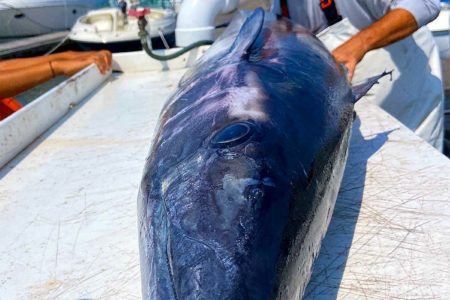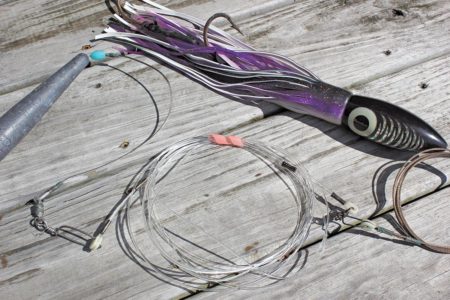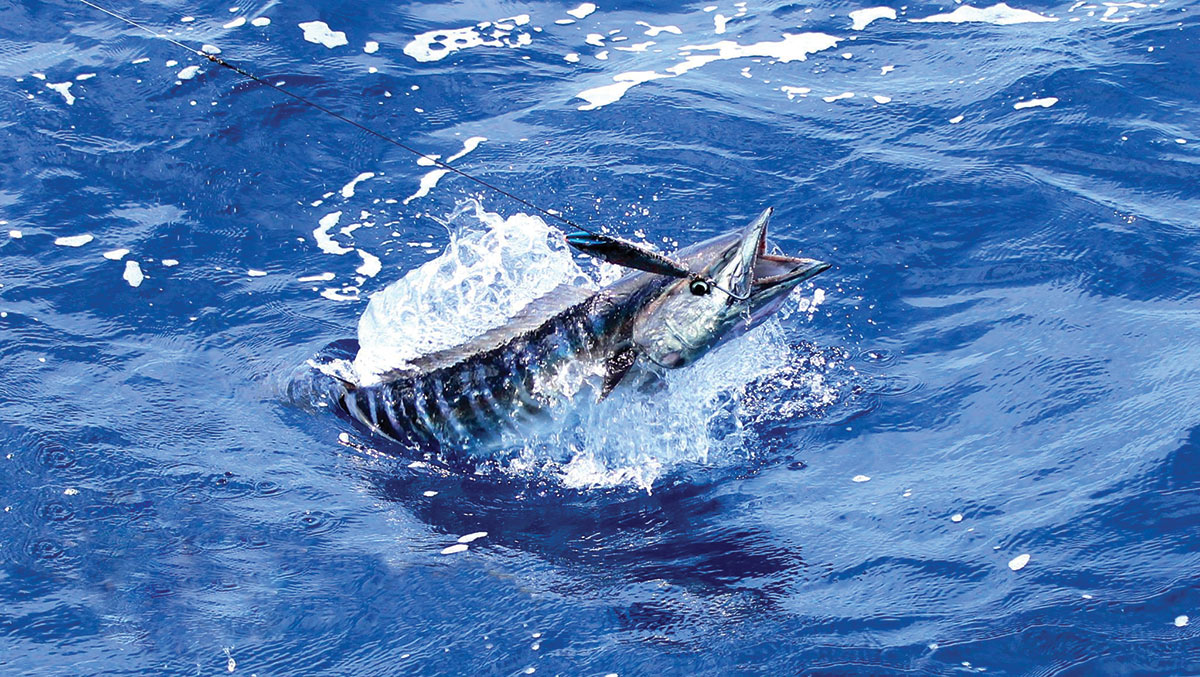
It might come as a surprise to some anglers but wahoo are a species that can and should be targetedhere in the Northeast.
While the window of opportunity is relatively short, if you travel to the 30-fathom curve or deeper, wahoo should be on your radar. Like most other pelagics, wahoo don’t adhere to a specific calendar. They arrive after mahi mahi have well established their presence, which is usually late July through September. More importantly, it’s when warmer Gulf Stream water makes its way inshore. Wahoo and white marlin can be commonly found in water ranging from low 70 to 80 degrees and it’s not uncommon to find them patrolling the 30-fathom line under those conditions.
Structure is always important when searching for an offshore bite. Structure can come in many different forms. There is physical structure, meaning any variation in bottom contour. This could be a fathom line, shelf, rockpile, wreck or reef. Find the cleanest, bluest and warmest water close to some form of structure and work it. Temperature breaks are another form of structure. Breaks usually form vertical barriers that congregate baitfish. Again, if you can find a break near physical structure that would be an optimum starting point. Work both sides of the break as your target may feed on one side while residing on the other. Weed lines or any floating debris are a mahimahi fisherman’s dream and it can be very difficult to get through these golden green beauties. After you’ve trolled or chucked up a few mahi, and especially if you get bit off, try switching over to a wahoo spread and pick up the pace.Trolling at 8 to 12 knots in the same area where the mahi were caught often pays off with a silver torpedo with razor sharp teeth.
The Bite
Distinguishing a wahoo bite, especially if you have never tangled with one before, can be an eye opening experience. Unless an angler is specifically targeting wahoo or trolling for sharks, odds are they are using a mono based leader system. This means that the first signs of wahoo being present are generally overlooked. When a wahoo strikes they make a blistering first run that often severs the leader immediately. The fact that it’s a solo hit of tremendous force should be your first clue. There are many differences between bluefish and wahoo strikes. Bluefish travel in very large schools, and the initial hit is nowhere near the speed and veracity of a wahoo. As you bring in your other lines keep an eye on the spread; bluefish often show themselves chasing the lures right to the boat. Check all of your leaders; if you spot nicks and mono curls on a few, odds are it was bluefish. If you had one rod go down with a blistering run and the cut off was with surgical precision, and nothing else in the spread was touched, odds are it was a shark or a wahoo. If it was a shark the rod would be doubled over by the weight and the speed. The rod bend would change as the fish alters direction and the massive amount of weight shifts. A hooked wahoo blasts in one direction with just speed. So the rod often doesn’t bend as much while line melts off the spool. Oftentimes it tires itself out from the initial run, or submits to the pressure and swims back towards the boat. If you pay attention and know the characteristics of each strike they are easily identified.
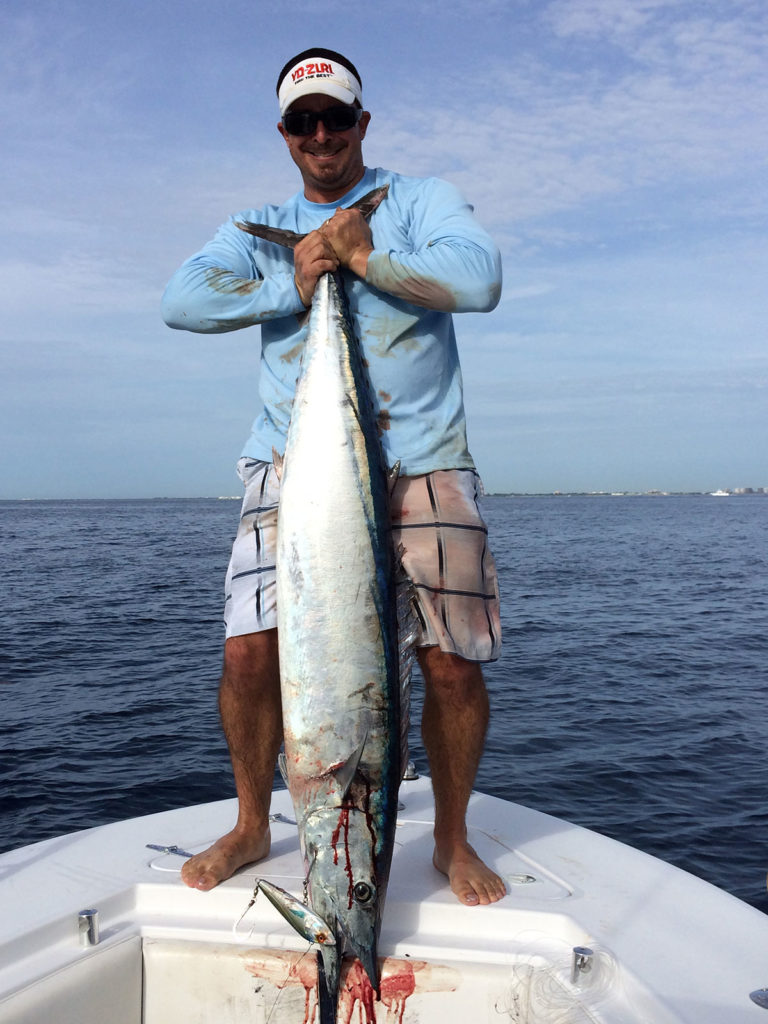
So you’re trolling for tuna at let’s say the Coimbra and you get a blistering run from a fish that hasn’t loaded up the rod with much weight when pop goes your leader. You reel in the line and find no chaffing, just a clean cut piece of mono. You think to yourself no way that was a shark, unless it was a very small mako. Now what? Slow or stop the boat and clear the rest of your lines. Inspecting all of the leaders. If they all come back clean, odds are it wasn’t bluefish. Re-deploy the spread with high speed lures rigged with cable. Put out four to six rods and start working the area. Troll 8 to 12 knots and vary the speed and direction. Keep an eye on the sounder and water temperature as you cover greater distances at the higher speeds, and note any marks that appear to be fishy. If after a decent attempt no other bites present themselves, set your tuna spread back out. Using the intel you just gathered, go back over areas that may have higher probabilities of producing. If you didn’t mark anything worth exploring, then you discovered where not to fish. Deploy your tuna spread and try other areas.
Another option is to change your spread to single strand wired ballyhoo or lures rigged with abrasion resistant fluorocarbon. Use chin weights to help ballyhoo track straight at higher speeds and skirts to prevent them from washing out. This will allow you to continue trolling for tuna, and if wahoo are present you have a greater probability of landing one.
What to Troll
The tried and true lures for wahoo are the Yo-Zuri “Bonita” and the hi-speed diving plug “Hydro Magnum.” New to the market is the high speed Vibe. Whatever you use it must be rigged with a tooth-proof leader, or you will be throwing your money away when it is bit off. Leaders can be constructed out of cable, single strand wire or hard fluorocarbon. The Bonita style lure works best with 275-pound cable but 400 is also a suitable option. The high speed Vibe is often rigged with #10 single strand 175-pound test. Tournament fishermen have been crimping 150-pound fluoro to these lures with great results. The number of strikes increases, and sometimes you will be surprised with a tuna or white marlin. However you must carefully inspect the leader after every hit. If the outer layer is compromised cut it shorter or re-rig completely. Any nick, cut or fray will cost you the next fish if not eliminated.
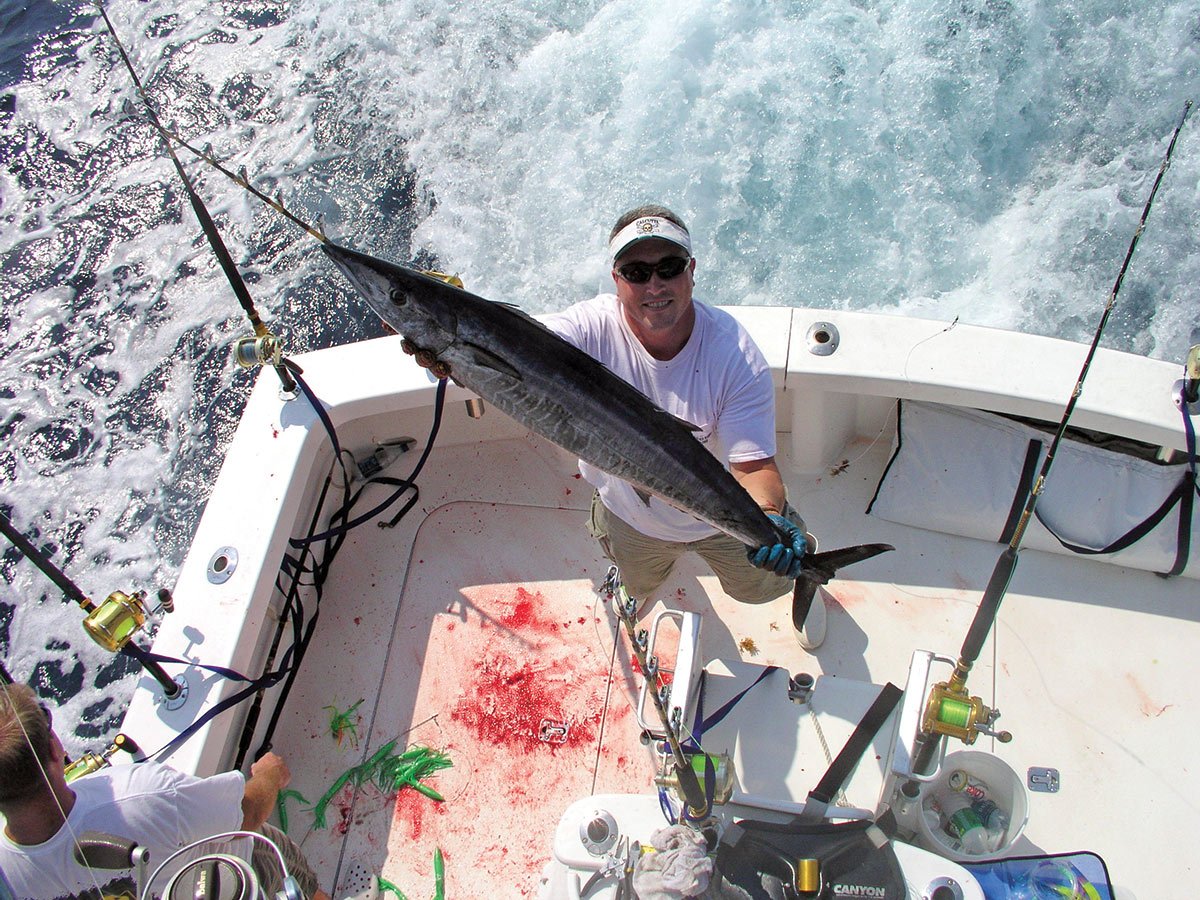
Another consideration is lure strength. A hard, indestructible body is a must. The Yo-ZuriVibe utilizes a solid “power body” system with through-wire construction, and 4x treble hooks. This may seem a bit overkill, but trust me, if you want more than one use out of your lure, leave the cheap plastic stuff home. Wahoo are fast and strong and can destroy substandard materials. As you become successful your lures will get beat up. Like a good pair of weathered jeans, beat up lures often become your best choice. As long as they track well keep using them. Chewed up paint finishes and gashes often out preform brand new out of the box lures. Personally, I have had my best luck with the Bonita in purple/black and orange/black. This may have to do more with the time of day and where the sun is positioned. Normally I spend the early hours specifically trolling for tuna. We normally target wahoo later in the day, and the darker colors may stand out better when the sun is high in the sky.
What to Expect
A blistering initial run, with a disappointing finish. When you first hookup you might think a very large tuna or marlin was hooked. Normally after that initial run you will be able to gain most of the line back quickly, though the fish might make take a few subsequent short bursts during the fight. Oftentimes they swim toward you, so if you think you’ve dropped the fish, reel as fast as you can. The angler must always keep a bend in the rod and keep reeling. Always maintain pressure and stay in touch with your fish. When you see color, the boat should be put in gear. This allows the fish to lay out in the water. As it gets close steer it to one side in range of a gaff shot. A small 4-inch gaff head is perfect. These fish are long and thin and a large gaff hook may make it more difficult to stick. Sink the gaff in and relax. Bring the fish over the gunnel and preferably directly into a fishbox or cooler bag. This is where some serious accidents occur as wahoo have extremely sharp teeth. Act as if the fish has a broken bottle in its mouth. If the fish swipes anyone it will most likely result in a trip to the emergency room and stitches. Do not slam the fish on the deck and allow it to bounce around. Take special care in controlling it and keep everyone safe.


Stay on top ofthe offshore fishing reports posted towards the back of this magazine. Don’t just read them prior to a trip, but read them weekly to discover any patterns that may be developing over the course of the season. This enables you to be prepared and know what to expect. It was mentioned earlier that both white marlin and wahoo can be caught together. White marlin will not bite through leaders like wahoo, and there is no mistaking their identity once they take to the air. When you read reports of fishermen hooking white marlin, it’s time to look for wahoo. You will also hear of fishermen breaking off what must have been a large tuna, but keep in mind that wahoo make tremendous initial runs and often bite themselves free, causing the angler to suspect it was a tuna. Use this information to identify the presence of wahoo. Keep the proper lures on the ready and give wahoo trolling a try. If you are successful you will be treated to one of the ocean’s finest delicacies.
